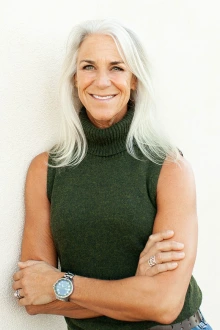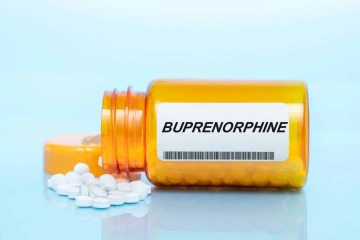Normalizing opioid use disorder treatments to improve care
Comprehensive Center for Pain & Addiction leaders are increasing access to care and treatment for people with opioid use disorder through education, research and policy.

Primary care providers have the ability to prescribe two out of the three approved medications for opioid use disorder, but in Arizona, few offer the treatments to their patients. Researchers and physician-scientists at the Comprehensive Center for Pain & Addiction hope to change that.
In Arizona, when a person with chronic pain visits a doctor for treatment, they might be prescribed one of several readily available pain-relieving medications, including buprenorphine, a synthetic opioid that can be dispensed at the nearest pharmacy.

Beth Meyerson, MDiv, PhD, researches harm reduction, which includes making sure that people have access to medications for opioid use disorder.
If a person with opioid use disorder wants to see a doctor for treatment in Arizona, their first hurdle is finding one who can and will prescribe medications for opioid use disorder, or MOUD. Sometimes their own primary care provider will refer them away for treatment, even though today all primary care providers are able to prescribe two medications for opioid use disorder.
In addition to being used for pain management, buprenorphine is one of three medications approved by the Food and Drug Administration to treat opioid use disorder. The other two are methadone and naltrexone. While evidence supports the effectiveness and safety of these medications, they are underutilized for a variety of reasons, including history, policy and stigma.
At the University of Arizona Health Sciences, members of the Comprehensive Center for Pain & Addiction are working to bring opioid use disorder treatment into the mainstream of health care, which includes expanding access to medication-assisted treatments such as buprenorphine.
“We emphasize to providers, patients and the public that opioid use disorder treatment is primary care,” said Beth Meyerson, PhD, policy director for the Comprehensive Center for Pain & Addiction and a professor and director of the Harm Reduction Research Lab at the UArizona College of Medicine – Tucson’s Department of Family and Community Medicine. “We focus on improving opioid use disorder treatment – the quality of it and access to it – to increase wellness and even reduce opioid overdose and deaths.”
“Access to evidence-based standard-of-care treatment for opioid use disorder will reduce opioid overdose deaths by 60% – some studies document 80% reduction,” Meyerson added. “That's life changing when we think about the fact that one person dies every five minutes from an opioid overdose in the United States.”
The safer opioids
When a person ingests, smokes or injects an opioid, it binds to opioid receptors located on cells in the brain. The receptors activate cellular pathways that block pain, lower stress and release dopamine, thereby boosting feelings of pleasure. This physiological response is what makes opioids effective for treating pain, but also highly addictive.

Buprenorphine is a synthetic opioid that was first developed as a pain-relieving medication and later approved as a treatment for opioid use disorder.
Methadone is a full agonist, meaning it activates 100% of the opioid receptor. It is approved for pain management and to treat opioid use disorder. As a MOUD, it is highly effective at relieving withdrawals and preventing cravings and has lower abuse and overdose potential than opioids such as oxycodone, codeine, hydrocodone or heroin. When used to treat people with opioid use disorder, methadone can only be dispensed through an Opioid Treatment Program certified by the Substance Abuse and Mental Health Services Administration.
Naloxone and naltrexone are antagonists, which mean they completely block the opioid receptors without activating them. Naloxone is a fast-acting medication that rapidly reverses an opioid overdose. Naltrexone is long acting and used to help prevent relapses into alcohol or opioid abuse.
Buprenorphine is a partial agonist, so it only activates some of the opioid receptors. Similar to methadone, when used to treat opioid use disorder it is highly effective at relieving withdrawal symptoms and decreasing cravings. It also is highly effective at treating moderate to severe acute pain and is safer than opioids with a lower potential for abuse or overdose.
MOUD: a checkered past
“We have a culture of pain – we do not like pain, we are not accustomed to pain. We are told that pain is bad, avoid it at all costs, and we are dealing with the byproduct of that thought process,” Maria Manriquez, MD, said, referring to the ongoing national opioid epidemic. “Why has it taken until 2024 to finally focus on the treatment of pain and addiction?”
Manriquez is the Comprehensive Center for Pain & Addiction’s Phoenix branch director and an obstetrician-gynecologist, addiction medicine specialist and professor at the UArizona College of Medicine – Phoenix. Her clinical practice at Banner – University Medical Center Phoenix focuses on substance use disorders in pregnant and parenting people and increasing access to care. She believes the current state of addiction medicine was influenced by a pivotal law that was enacted more than a century ago: the Harrison Narcotics Act of 1914.

More than 220 people died every day from an overdose in 2021, according to the Centers for Disease Control and Prevention. That number could be significantly reduced by increasing access to evidence-based standard-of-care treatment for opioid use disorder.
“The Harrison Act was not a prohibition act, but it basically said that we physicians should not treat patients with addiction with opioids,” Manriquez said. “Ultimately, it became significantly taboo – so off-limits that doctors weren’t well trained. There are a lot of providers out there who were never taught how to identify a use disorder or how to manage it.”
Management options for opioid use disorder remained limited until the middle of the 20th century. Methadone, first approved as a long-acting analgesic in 1947, underwent testing to examine its potential as an opioid use disorder treatment in the early 1960s. It was approved in 1972 and has been strictly regulated since, resulting in access issues for patients who cannot travel to an Opioid Treatment Program every day to receive the single dose they are allotted.
Buprenorphine was discovered and synthesized in 1966. In the UK, an injectable form was approved as an analgesic in 1977, followed by a tablet form in 1980. By 1985, buprenorphine was available worldwide as a pain-relieving medication.
Through the 1970s and ’80s, scientists diligently studied buprenorphine’s potential as a treatment for opioid use disorder. In 1990, the National Institute on Drug Abuse reviewed a preliminary paper, eventually published in JAMA, which found that opioid-dependent, heroin-using participants used significantly less opioids when taking buprenorphine and had better retention than participants who were taking methadone.
Two buprenorphine products, Subutex®, containing only buprenorphine; and Suboxone®, a buprenorphine/naloxone combination, received FDA approval in 2002.
Moving forward, modernizing laws
Buprenorphine was meant to increase access to care for opioid use disorder by allowing some physicians in office-based settings to prescribe the medication. After completing eight hours of training, physicians were given a waiver to prescribe buprenorphine to no more than 30 patients the first year. The second year, they could treat 100 patients.

In addition to her clinical practice, Maria Manriquez, MD, pursues research and advocacy aimed at investigating innovations in prenatal care models addressing maternal morbidity and mortality, preterm delivery rate and substance use disorders in pregnancy.
Fifteen years later, a comprehensive opioid bill signed into law in 2018 allowed for nurses to become waivered practitioners; and waivered physicians could prescribe MOUD for up to 275 patients. In 2021, the Department of Health and Human Services changed practice guidelines to allow any provider to prescribe buprenorphine for up to 30 patients without a waiver.
The changes were intended to increase access to care, but did they?
In 2022, Meyerson led a “secret shopper” study that assessed the accuracy of government-maintained lists of Arizona providers prescribing MOUD and the extent to which these providers are accessible for treatment. The study, published in the Journal of Substance Use and Addiction Treatment, attempted to contact more than 2,300 providers who were listed by the Drug Enforcement Agency and the Substance Abuse and Mental Health Service Administration as prescribing methadone or buprenorphine.
“Our secret shopper study demonstrated that only 36% of the government-listed providers were actually providing MOUD,” Meyerson said.
The study also found that 91.2% of Arizona doctors who could prescribe buprenorphine were in urban areas, resulting in a lack of access to care and health disparities for people in rural Arizona communities.
“Of those, 26% were not accepting new patients,” Meyerson added.
Last year, the Consolidated Appropriations Act, also known as the Omnibus Bill, completely removed the waiver requirement for practitioners to prescribe medications, including buprenorphine, for the treatment of opioid use disorder.
That change, along with educational efforts aimed at training future providers, give Meyerson and Manriquez hope for the future.
“Today, we are lucky in that we have pain and addiction medicine fellowships,” Manriquez said of the resident-training programs that are available at the Colleges of Medicine in Tucson and Phoenix, respectively. “We are helping residents learn to identify opioid use disorder, and then giving them the tools and hope for the future on how to manage pain and addiction.”
“I, along with other faculty, make sure future and new physicians are ready to practice the full range of primary care, which includes providing treatment for opioid use disorder,” Meyerson added. “Ours is just one discipline piping into primary care, so we are studying the likelihood that future primary care providers from all incoming disciplines will manage their patients on buprenorphine and eventually methadone.”
Still, there is much work to be done to assure that treatment for opioid use disorder is equitable and accessible for all.
“Buprenorphine is very easy to get on the street, and the reasons people buy buprenorphine illicitly, I think, are because, one, withdrawal sucks, and two, there aren't enough providers to treat patients,” Manriquez said. “We need to work with our legislators to amend laws and regulations, increase funding for pain and addiction research, and expand access to treatment options. We are the voice of our patients.”
Experts
Beth Meyerson, MDiv, PhD
Policy Director, Comprehensive Center for Pain & Addiction, UArizona Health Sciences
Professor, Family and Community Medicine, College of Medicine – Tucson
Director, Harm Reduction Research Lab, Family and Community Medicine, College of Medicine – Tucson
Maria Manriquez, MD
Phoenix Branch Director, Comprehensive Center for Pain & Addiction, UArizona Health Sciences
Professor, Obstetrics & Gynecology, College of Medicine – Phoenix
Physician Lead, Pain and Addiction Medicine Curriculum, College of Medicine – Phoenix
Director, Pathway Scholars Program, College of Medicine – Phoenix
Contact
Stacy Pigott
UArizona Health Sciences Office of Communications
520-539-4152, spigott@arizona.edu

